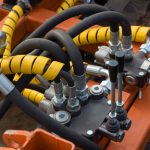Avoiding Contamination in Hydraulic Assemblies

Understanding Contamination:
Contamination in hydraulic assemblies refers to the presence of foreign particles, such as dirt, debris, or moisture, that can negatively impact the system’s performance. These particles can enter the system through various means, including improper handling and storage, poor maintenance practices, or even faulty components. Once inside the system, contaminants can clog filters, damage seals, and compromise the overall efficiency of the hydraulic system.
Strategies to Prevent Contamination:
1. Proper Handling and Storage:
The first line of defense against contamination is ensuring proper handling and storage of hydraulic components and assemblies. Components should be stored in clean and dry areas, away from dust, moisture, and other potential contaminants. Proper handling techniques, such as using clean gloves and avoiding contact with dirty surfaces, also play a crucial role in preventing contamination.
2. Regular Maintenance and Inspections:
Regular maintenance and inspections are essential to keep hydraulic assemblies free from contamination. This includes checking and replacing filters regularly to ensure they are trapping contaminants effectively. It is also important to inspect hoses, fittings, and seals for any signs of wear or damage that could lead to leaks or the entry of contaminants.
3. Flushing and Cleaning Procedures:
Another effective strategy to prevent contamination is by implementing flushing and cleaning procedures during assembly or when replacing components. Flushing involves circulating a cleaning fluid through the hydraulic system to remove any debris or contaminants. This process should be done before installing new components or replacing filters to ensure a clean and contamination-free system.
4. Proper Filtration Systems:
Choosing the right filtration system for your hydraulic assembly is crucial to prevent contamination. Filters should be selected based on the specific requirements of the system, taking into consideration factors such as flow rate, particle size, and filtration efficiency. Regularly monitoring and replacing filters as recommended by the manufacturer will ensure optimal filtration performance and prevent contaminants from entering the system.
5. Contamination Prevention Tools:
There are various tools available in the market designed specifically to prevent contamination in hydraulic systems. For example, breathers or desiccant breathers can be installed on reservoirs to remove moisture and prevent dust and debris from entering the system. Magnetic filters can also be used to attract and collect ferrous contaminants, preventing them from circulating through the system.
6. Training and Education:
Proper training and education of personnel handling hydraulic assemblies are crucial to avoiding contamination. It is important to educate operators and maintenance staff about the risks and consequences of contamination, as well as the best practices to prevent it. This includes teaching them how to properly handle, store, and maintain hydraulic components and assemblies.
Summary:
Avoiding contamination in hydraulic assemblies is essential for maintaining the performance and longevity of hydraulic systems. By implementing strategies such as proper handling and storage, regular maintenance and inspections, flushing and cleaning procedures, proper filtration systems, the use of contamination prevention tools, and providing training and education, you can significantly reduce the risk of contamination. By prioritizing contamination prevention, you can ensure the reliability and efficiency of your hydraulic assemblies, minimize downtime, and reduce costly repairs and replacements.
Need Hose & Fittings Specialists in San Jose, CA?
Welcome Royal Brass Incorporated! We are your 3rd generation, family-owned, local hose supplier! Our family has dedicated our services to supplying northern California with all types of hoses, fittings, flanges, regulators, valves, adapters, and gauges. We pride ourselves on having the most extensive inventory in northern California. Our inventory ensures that we can fix most products on site, the same day. Here at Royal Brass Incorporated, we only hire qualified individuals who are trained in factory sales. Our fully stocked warehouses ensure that we can fill your hydraulic and pneumatic hose, tubing, and fitting needs on time, every time. High-quality customer service is our goal and has been since 1952. Contact us today!
Categorised in: Hydraulic Equipment, Hydraulic Systems





